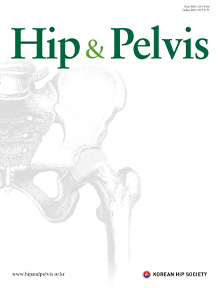Original Article
Hip Pelvis 2013; 25(3): 166-172
Published online September 1, 2013
https://doi.org/10.5371/hp.2013.25.3.166
© The Korean Hip Society
Cementless Total Hip Arthroplasty Using the ABG I Hydroxyapatite-coated Prosthesis : Minimum 10 Year Follow-up
Correspondence to : Young-Ho Kim, MD
Department of Orthopaedic Surgery, Hanyang University Guri Hospital, 249-1 Kyomun-dong, Guri 471-701, Korea
TEL: +82-31-560-2312 FAX: +82-31-557-8781
E-mail: kimyh1@hanyang.ac.kr
This is an Open Access article distributed under the terms of the Creative Commons Attribution Non-Commercial License (http://creativecommons.org/licenses/by-nc/3.0) which permits unrestricted non-commercial use, distribution, and reproduction in any medium, provided the original work is properly cited.
Purpose: The purpose of this study was to evaluate the outcomes of total hip arthroplasty (THA) with an ABG I hip prosthesis after a minimum ten-year follow up.
Materials and Methods: From January 1996 to March 2001, 121 hips in 104 patients, whi were followed up for a minimum of ten-years, were enrolled in this study. The clinical and radiographic outcomes were evaluated and Kaplan-Meier survival analysis was performed.
Results: The mean Harris hip score at the last follow-up was 84 points. A radiolucent line around the cup, osteolysis, and cup loosening were observed in 5 hips(4.1%), 53 hips(43.8%), and 5 hips(4.1%), respectively. In the femoral side, osteolysis and stem loosening were observed in 11 hips(9.1%) and 2 hips(1.7%), respectively. The mean linear wear rate of the polyethylene liner was 0.23 mm/yr. Forty four revisions(36.3%) were performed. The outcomes were similar regardless of the cause of primary THA. The survival rate with the end point of revision due to cup loosening was 56.3%, and revision due to stem loosening was 98.1% after a 16 year follow-up.
Conclusion: High polyethylene wear and the disappointing survival rate of the ABGI cup were observed after a minimum ten year follow-up. Therefore, close observation of patients who have received an ABG I prosthesis is necessary.
Keywords Hip, ABG I, Osteolysis, Polyethylene wear
Article
Original Article
Hip Pelvis 2013; 25(3): 166-172
Published online September 1, 2013 https://doi.org/10.5371/hp.2013.25.3.166
Copyright © The Korean Hip Society.
Cementless Total Hip Arthroplasty Using the ABG I Hydroxyapatite-coated Prosthesis : Minimum 10 Year Follow-up
Yee-Suk Kim, MD, Dong-Hyuck Park, MD, Kyu-Tae Hwang, MD, Young-Ho Kim, MD*, Il-Yong Choi, MD
Department of Orthopedic Surgery, Hanyang University Hospital, Seoul, Korea
Department of Orthopedic Surgery, Hanyang University Guri Hospital, Guri, Korea*
Correspondence to:Young-Ho Kim, MD
Department of Orthopaedic Surgery, Hanyang University Guri Hospital, 249-1 Kyomun-dong, Guri 471-701, Korea
TEL: +82-31-560-2312 FAX: +82-31-557-8781
E-mail: kimyh1@hanyang.ac.kr
This is an Open Access article distributed under the terms of the Creative Commons Attribution Non-Commercial License (http://creativecommons.org/licenses/by-nc/3.0) which permits unrestricted non-commercial use, distribution, and reproduction in any medium, provided the original work is properly cited.
Abstract
Purpose: The purpose of this study was to evaluate the outcomes of total hip arthroplasty (THA) with an ABG I hip prosthesis after a minimum ten-year follow up.
Materials and Methods: From January 1996 to March 2001, 121 hips in 104 patients, whi were followed up for a minimum of ten-years, were enrolled in this study. The clinical and radiographic outcomes were evaluated and Kaplan-Meier survival analysis was performed.
Results: The mean Harris hip score at the last follow-up was 84 points. A radiolucent line around the cup, osteolysis, and cup loosening were observed in 5 hips(4.1%), 53 hips(43.8%), and 5 hips(4.1%), respectively. In the femoral side, osteolysis and stem loosening were observed in 11 hips(9.1%) and 2 hips(1.7%), respectively. The mean linear wear rate of the polyethylene liner was 0.23 mm/yr. Forty four revisions(36.3%) were performed. The outcomes were similar regardless of the cause of primary THA. The survival rate with the end point of revision due to cup loosening was 56.3%, and revision due to stem loosening was 98.1% after a 16 year follow-up.
Conclusion: High polyethylene wear and the disappointing survival rate of the ABGI cup were observed after a minimum ten year follow-up. Therefore, close observation of patients who have received an ABG I prosthesis is necessary.
Keywords: Hip, ABG I, Osteolysis, Polyethylene wear

Article Tools
Stats or Metrics
Related articles in H&P
-
Cementless Total Hip Arthroplasty with Circumferentially Proximal Porous-Coated Femoral Stem -Minimum 10-Year Follow-up Results
Chang Dong Han, Jin Park, Dong Hoon Lee and Ick Whan Yang
J Korean Hip Soc 2006; 18(4): 139-145 -
Change of Symptoms after Total Hip Arthroplasty in Patients with Hip-Spine Syndrome
Sung-Hyun Yoon, MD, Ju Hyun Kim, MD, Hyung Jun Lee, MD, Ki-Choul Kim, MD, PhD
Hip Pelvis 2023; 35(4): 238-245 -
Short-term Results of Cementless Ceramic-on-ceramic Articulation Total Hip Arthroplasty
Won-Sik Choi, M.D., Jae Hoon Ahn, M.D., Kyu-Hyun Na, M.D., and Seung Kwon Kim, M.D.
J Korean Hip Soc 2007; 19(1): 16-20




 PDF
PDF Standard view
Standard view Export citation
Export citation Share
Share  Previous Article
Previous Article



